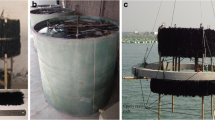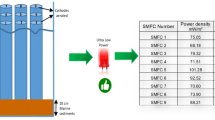Abstract
Microbial fuel cell (MFC) on the ocean floor is a kind of novel energy- harvesting device that can be developed to drive small instruments to work continuously. The shape of electrode has a great effect on the performance of the MFC. In this paper, several shapes of electrode and cell structure were designed, and their performance in MFC were compared in pairs: Mesh (cell-1) vs. flat plate (cell-2), branch (cell-3) vs. cylinder (cell-4), and forest (cell-5) vs. disk (cell-6) FC. Our results showed that the maximum power densities were 16.50, 14.20, 19.30, 15.00, 14.64, and 9.95 mWm−2 for cell-1, 2, 3, 4, 5 and 6 respectively. And the corresponding diffusion-limited currents were 7.16, 2.80, 18.86, 10.50, 18.00, and 6.900 mA. The mesh and branch anodes showed higher power densities and much higher diffusion-limited currents than the flat plate and the cylinder anodes respectively due to the low diffusion hindrance with the former anodes. The forest cathode improved by 47% of the power density and by 161% of diffusion-limited current than the disk cathode due to the former’s extended solid/liquid/gas three-phase boundary. These results indicated that the shape of electrode is a major parameter that determining the diffusion-limited current of an MFC, and the differences in the electrode shape lead to the differences in cell performance. These results would be useful for MFC structure design in practical applications.
Similar content being viewed by others
References
Cheng, S. A., and Logan, B. E., 2007. Ammonia treatment of carbon cloth anodes to enhance power generation of microbial fuel cells. Electrochemistry Communications, 9: 492–496.
Delong, E. F., and Chandler, P., 2002. Power from the deep. Nature Biotechnology, 20: 788–789.
Fukunaga, H., Ihara, M., Sakaki, K., and Yamada, K., 1996. The relationship between overpotential and the three-phase boundary length. Solid State Ionics, 86–88: 1179–1185.
He, Z., Minteer, S. D., and Angenent, L. T., 2005. Electricity generation from artificial wastewater using an upflow microbial fuel cell. Environmental Science and Technology, 39(14): 5262–5267.
Li, J. H., Fu, Y. B., Liu, J., Li, A. L., and Ma, D. D., 2009. Effect of electrode shape on power and internal resistance in benthic microbial fuel cell material in marine sediment. Advanced Materials reasearch, 79–82: 2195–2198.
Liu, H., Ramnarayanan, R., and Logan, B. E., 2004. Production of electricity during wastewater treatment using a single chamber microbial fuel cell. Environmental Science and Technology, 38(7): 2281–2285.
Logan, B. E., Cheng, S., Watson, V., and Estadt, G., 2007. Graphite fiber brush anodes for increased power production in air-cathode microbial fuel cells. Environmental Science and Technology, 41: 3341–3346.
Mao, Y. P., Cai, L. K., Zhang, L. H., Hou, H. P., Huang, G. T., and Liu, Y. D., 2009. Biocathodes in microbial fuel cells. Progress in Chemistry, 21(7/8): 1672–1677.
Nielsen, M. E., Reimers, C. E., and Stecher, H. A., 2007. Enhanced power from chambered benthic microbial fuel cells. Environmental Science and Technology, 41(22): 7895–7900.
Nielsen, M. E., Wu, D. M., Girguis, P. R., and Reimers, C. E., 2009. Influence of substrate on electron transfer mechanisms in chambered benthic microbial fuel cells. Environmental Science and Technology, 43(22): 8671–8677.
Park, D. H., and Zeikus, J. G., 2002. Impact of electrode composition on electricity generation in a single-compartment fuel cell using Shewanella putrefucians. Applied Microbiology and Biotechnology, 59: 58–61.
Reimers, C. E., Tender, L. M., Fertig, S. J., and Wang, W., 2001. Harvesting energy from the marine sediment-water interface. Environmenal Science and Technology, 35(1): 192–195.
Wang, G., Huang, L. P., and Zhang, Y. F., 2008. Study and application of biological cathode in microbial fuel cells. Environmental Science and Technology, 31: 101–103.
Yu, E. H., Cheng, S., Scott, K., and Logan, B., 2007. Microbial fuel cell performance with non-Pt cathode catalysts. Journal of Power Sources, 171(2): 275–281.
Zhao, F., Slade, R. C., and Varcoe, J. R., 2009. Techniques for the study and development of microbial fuel cells: an electrochemical perspective. Chemical Society Reviews, 38: 1926–1939.
Zou, Y. J., Xiang, C. L., Yang, L. N., Sun, L. X., Xu, F., and Cao, Z., 2008. A mediatorless microbial fuel cell using polypyrrole coated carbon nanotubes composite as anode material. International Journal of Hydrogen Energy, 33(18): 4856–4862.
Author information
Authors and Affiliations
Corresponding author
Rights and permissions
About this article
Cite this article
Fu, Y., Liu, J., Su, J. et al. Electrochemical properties of electrodes with different shapes and diffusion kinetic analysis of microbial fuel cells on ocean floor. J. Ocean Univ. China 11, 25–31 (2012). https://doi.org/10.1007/s11802-012-1808-y
Received:
Revised:
Accepted:
Published:
Issue Date:
DOI: https://doi.org/10.1007/s11802-012-1808-y




